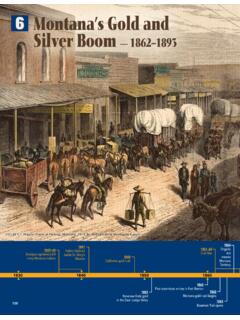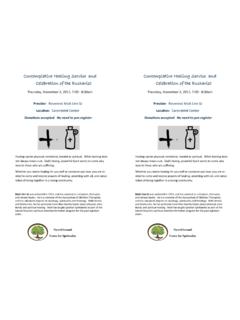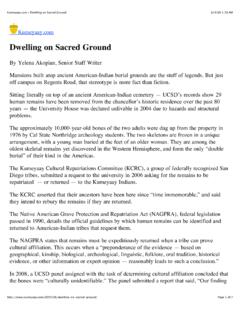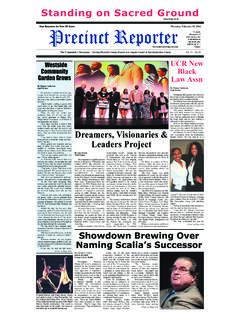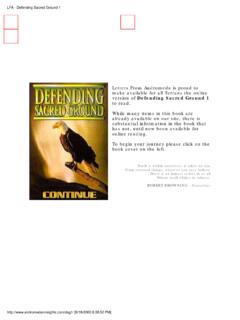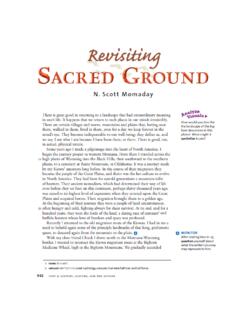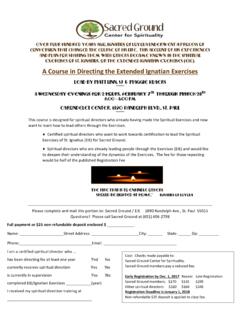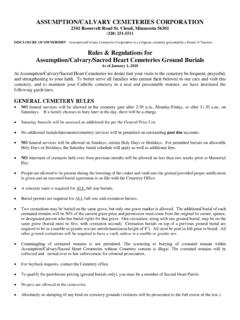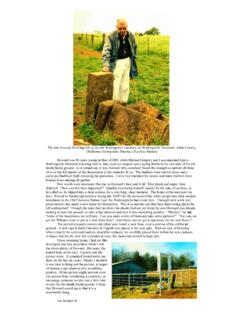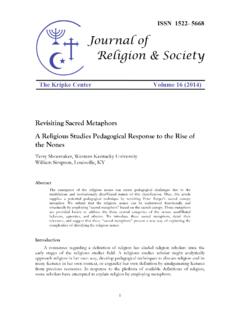Transcription of Mining Sacred Ground - Montana
1 Mining Sacred Ground : IEFA LESSON PLAN, PAGE 1 Mining Sacred GroundEnvironment, Culture, and Economic Development on the Northern Cheyenne ReservationGrade level7th 12th gradeTime neededOne to four days Standards correlationThe activity that follows reflects the Essential Understandings Regarding Montana Indians and the Montana Social Studies Content Stan-dards as developed by the Montana Office of Public Instruction. The exercise will align with Essential Understandings 1, 2, 3, and 6 and with Social Studies Content Standards , , , , , and and purposeThis current events activity is intended to supple ment topics addressed in Chapter 22 of the Montana Historical Society s middle school Montana history textbook, Montana : Stories of the Land. It has been designed to be adapted to a variety of lengths and approaches, in order to make it as useful as possible for the classroom teacher.
2 The activity relies heavily on recent source materials, such as government documents and newspaper accounts, to familiarize students with an important and contentious issue now facing Montana s native peoples: whether or not to develop their reservation s coal and coalbed methane resources. This exercise par-ticularly focuses on the Northern Cheyenne Reservation. The goal of this activity is to challenge youngsters to better appreciate the complexities of promoting resource-based eco-nomic develop ment when such action conflicts with traditional cultural values. By the end of the exercise, students should also understand that tribal members differ in their attitudes toward resource extraction. This dovetails nicely with Essential Understanding 1: there is great diversity among individual American Indians.
3 Seeking to shed a balanced light on the subject by viewing it from very different perspectives, this activity relies heavily on the actual words of tribal members to help students explore the subject, raise related questions, and formulate their own opinions about this complicated and controversial issue. In this activity, students will: demonstrate comprehension of class readings piece together a meaningful narrative from various source materials analyze the quality of information used to support an argument create interpretive presentations apply previous knowledge of persuasive devices to discussion and a presentation articulate persuasive arguments in an in-class debate find, interpret, and manipulate textual evidence to support one side of an argument work effectively with other students demonstrate effective oral presentation skills analyze the quality of information used to support an descriptionIn this activity, students will learn of Sweet Medicine, a Cheyenne cultural hero who prophe-sized about the coming of Euro-Americans and Mining Sacred Ground .
4 IEFA LESSON PLAN, PAGE 2modern life [Document 1]. They will also read a contemporary news article [Document 2] that summarizes the controversy surrounding coal Mining and coalbed methane drilling on the Northern Cheyenne Reservation today. Last, students will read brief summaries of the argu-ments for coal development [Document 3] and against it [Document 4] to familiarize them-selves with both sides of the coal and coalbed methane development issue. Students will then use this information to form the basis of an in-class debate before a mock tribal council. Questions will help to focus student reading and set the stage for an active learning exercise and meaningful wrap-up discussion, during which recent developments on Montana s Northern Cheyenne Reservation will be discussed [Docu-ment 5].
5 Day 1 (Setting the Stage / Background)Today, as an anticipatory set, the instructor will read Sweet Medicine s prophecy [Document 1] and briefly discuss with the class its signifi-cance for the Cheyenne people. The prophecy addresses the environmental and cultural impacts of the arrival of Euro- Americans in the Cheyenne world. It will set the stage for a critical examination of the contemporary controversy surrounding the possible development of coal Mining on Montana s Northern Cheyenne Reservation. Following the reading and a brief class discus-sion, students will consider an informative 2003 article from High Country News [Document 2] that provides needed background information on the coal and coalbed methane development issue on the Northern Cheyenne Reservation. Based on the article, students will answer questions [Worksheet 1] to ensure their compre-hension of the issue.
6 If time remains, the teacher will go over the questions and clarify key issues as necessary. Students needing more time can take the article and questions home and com-plete the assignment as homework. Day 2 (Taking Sides)The teacher will discuss with students their opinions regarding what they feel the Northern Cheyenne should do with respect to developing their extensive coal and coalbed methane reserves, as indicated in the last question on the previous day s worksheet. Following the discussion, a poll will be conducted to determine where students stand. Those students inclined to support development rather than preservation will become team one. Those students inclined to support preservation rather than develop-ment will become team two. Three to five of those still undecided will be selected to serve as the tribal council.
7 The remaining students will be distributed among team one and team two to even up the team numbers. [Note: If the sides are not even, the teacher should randomly determine the two equally sized teams and the five-member tribal council.]Once the teams are determined, they will be given a document (either Document 3 Summary of Pro Coal Development Arguments or Document 4 Summary of Anti Coal Development Argu-ments) that supports their chosen position. Group members will read, take notes on, and discuss their document. With the time remain-ing, students will brainstorm other arguments and strategize on how best to convince the tribal council that their position is right. The best (most eloquent and convincing) speakers should be chosen to introduce and summarize their group s position. During this time, tribal council members will either read both posi-tion documents or simply mill about the room eavesdropping on but not participating in each group s discussion.
8 If time remains, tribal council members can also begin considering possible compromise solutions. Day 3 (The Debate)The teacher will ask the five tribal council mem-bers to sit in chairs in front of the classroom. They will serve as the judges for today s debate. Mining Sacred Ground : IEFA LESSON PLAN, PAGE 3 The teacher will instruct them to base their deci-sion not on their personal opinion but on the strengths and weaknesses of the arguments pre-sented by team one and team two. Tribal council members should take notes during the debate, as each member will be asked to explain his or her decision to the class following the debate. [Note: While it is expected that the Tribal Coun-cil members will vote in favor of or against coal and coalbed methane development on the North-ern Cheyenne Reservation, it is possible that they would choose to find a compromise of some sort.]
9 ]Each opening speaker will have up to two min-utes to clearly and forcefully present his or her side s position on coal development. Every other team member will have thirty to sixty seconds to respond to what has been said, reiterate a point, or make a new point in the coin will be flipped at the beginning of the debate, and a student will be randomly selected to call for his or her team. If the student calls correctly, he or she will choose whether the team wants the first word or the last word. If the stu-dent calls incorrectly, the other team will decide. The opening speaker for the team selected to have the first word will then present, followed by the opening speaker for the other team. Student speakers will then alternate presenting argu-ments for their team s position until all speakers have presented.
10 The debate will end with each of the designated final speakers making their closing arguments, with the last speaker being from the team that did not have the first the debate is over, the members of the tribal council will openly discuss their ideas regarding the debate. If time allows, they may ask questions. If, after all is said and done, there is consensus, the tribal council will make a deci-sion and explain their reasoning to both teams. If there is not consensus, the teacher will serve as a mediator and the tribal council will develop a compromise solution. Once a final decision and/or compromise is made, the tribal council will share the reasons for its decision with the rest of the class. Day 4 (Wrap-Up)Following the debate, the teacher will facilitate a wrap-up discussion.
